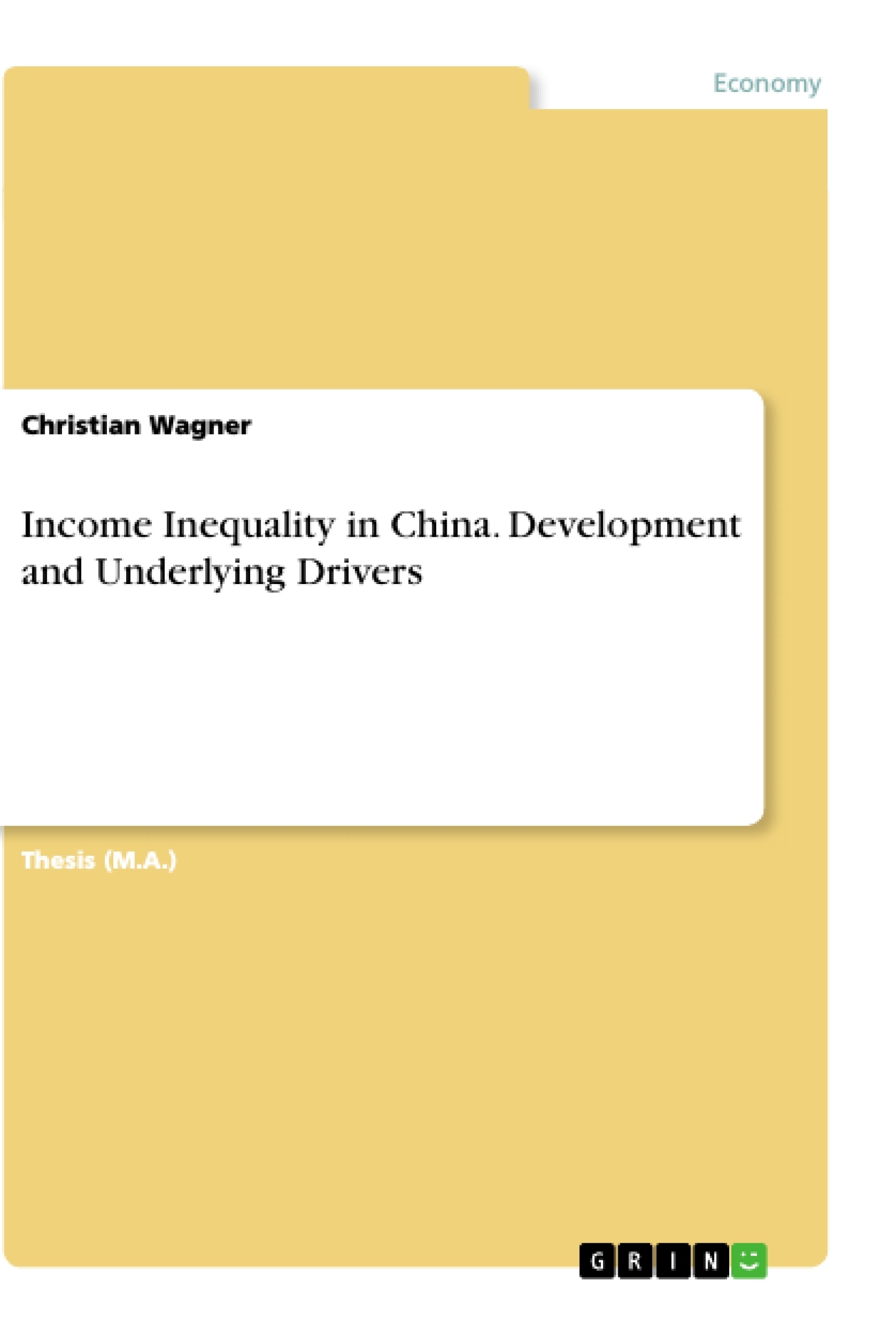This thesis aims to shed light to the various characteristics and sources of income inequality in China and thereby demonstrate their interrelations on economic growth using a literature review approach and by examining the impact of differences in the propensity to save among various Chinese income groups. In the course of this, China’s current degree of income inequality is established, while identifying various forces and drivers behind these changes since the economic opening process initiated in 1978.
Since adoption of the open-market policy reforms in 1978, China has experienced rapid economic growth. At the same time, its level of income inequality turned from one of the world's most equal to one of the most unequal. During long periods of time China was the country that experienced the fastest increase in income inequality. This bags the question whether income inequality is in fact the causal reason for economic growth or the necessary outcome of it. In the wake of this, income inequality in China has developed into several dimensions of inequality drivers ranging from an extensive urban-rural inequality, cross-regional inequality, inequality of education or wealth inequalities.
Inhaltsverzeichnis (Table of Contents)
- SECTION 1: Introduction
- SECTION 2: Theoretical Background
- 2.1 Definitions
- 2.1.1 Measurement of Income Inequality
- 2.1.2 Limitations of the Gini coefficient
- 2.1.3 Measurement of Economic Growth
- 2.2 Data
- 2.3 Theory on Economic Growth and the Distribution of Income
- 2.1 Definitions
- SECTION 3: Literature Review on Economic Growth and Income Inequality
- 3.1 Income Inequality: The Necessary Evil for the Sake of Economic Growth?
- 3.2 The impact of Income Inequality on Economic Growth
- 3.3 Long-term Implications of Income Inequality on Economic Growth
- 3.4 Relationship between Income Inequality and Economic Growth in China
- SECTION 4: Income Inequality in China
- 4.1 Extend of Income Inequality in China
- 4.2 Income Inequality and Insufficient Consumption
- 4.2 Overview of Policy Measures by the Chinese Government
- SECTION 5: Drivers of Income Inequality in China
- 5.1 Economic Opening Process
- 5.2 The Urban-Rural Income Gap
- 5.3 Educational Inequality
- 5.4 Regional Inequality
- 5.5 Inequality of Wealth
- 5.6 Demographic Change
- 5.7 China's Taxation System
- SECTION 6: Policy Recommendations
- 6.1 Taxation Reforms
- 6.2 Fiscal Policies
- 6.3 Dibao
Zielsetzung und Themenschwerpunkte (Objectives and Key Themes)
This master's thesis examines the development and underlying drivers of income inequality in China. It aims to provide a comprehensive analysis of the issue, exploring its historical evolution, theoretical underpinnings, and key factors contributing to its persistence. The work also delves into the implications of income inequality for China's economic growth and social development, including its potential impact on consumption and the effectiveness of government policies.
- The historical development of income inequality in China
- The theoretical frameworks used to understand income inequality and its impact on economic growth
- The identification of key drivers of income inequality in China, such as economic reforms, urbanization, education, regional disparities, and wealth inequality
- The analysis of the relationship between income inequality and consumption in China
- The evaluation of government policies and their effectiveness in addressing income inequality
Zusammenfassung der Kapitel (Chapter Summaries)
This section provides a summary of the main themes, arguments, or narrative elements of each chapter, excluding summaries of the conclusion, final chapter, or any sections containing major revelations or spoilers.
- Section 1: Introduction: This chapter provides an overview of the research topic, its relevance, and the structure of the thesis. It highlights the increasing concern over income inequality in China and its implications for the country's future development.
- Section 2: Theoretical Background: This chapter delves into the theoretical foundations of income inequality, focusing on definitions, measurement tools, and the relationship between income inequality and economic growth. It explores the concept of the Gini coefficient, its limitations, and the different perspectives on the role of inequality in economic development.
- Section 3: Literature Review on Economic Growth and Income Inequality: This section critically examines existing literature on the complex relationship between income inequality and economic growth. It explores the arguments for and against the idea that inequality is a necessary evil for achieving economic growth, analyzing the potential impact of inequality on economic performance in both the short and long term. It then focuses on the specific context of China, examining the relationship between income inequality and economic growth in the country's recent history.
- Section 4: Income Inequality in China: This chapter focuses on the extent and implications of income inequality in China. It analyzes trends in income inequality over time, presenting data on the distribution of income and the Gini coefficient. It examines the impact of inequality on consumption and the role of government policies in addressing the issue.
- Section 5: Drivers of Income Inequality in China: This section investigates the underlying factors contributing to income inequality in China. It examines the role of various economic, social, and demographic factors, including the impact of economic reforms, urbanization, educational disparities, regional inequality, wealth concentration, and demographic change. It also analyzes the impact of China's taxation system on income distribution.
- Section 6: Policy Recommendations: This chapter proposes policy recommendations to address income inequality in China. It focuses on taxation reforms, fiscal policies, and social safety net programs like Dibao, aiming to promote greater equality and social mobility while supporting sustainable economic growth.
Schlüsselwörter (Keywords)
Income inequality, China, economic growth, Gini coefficient, urbanization, education, regional disparities, wealth inequality, taxation, policy recommendations, consumption, social safety net, Dibao.
- Arbeit zitieren
- Christian Wagner (Autor:in), 2019, Income Inequality in China. Development and Underlying Drivers, München, GRIN Verlag, https://www.grin.com/document/899986



